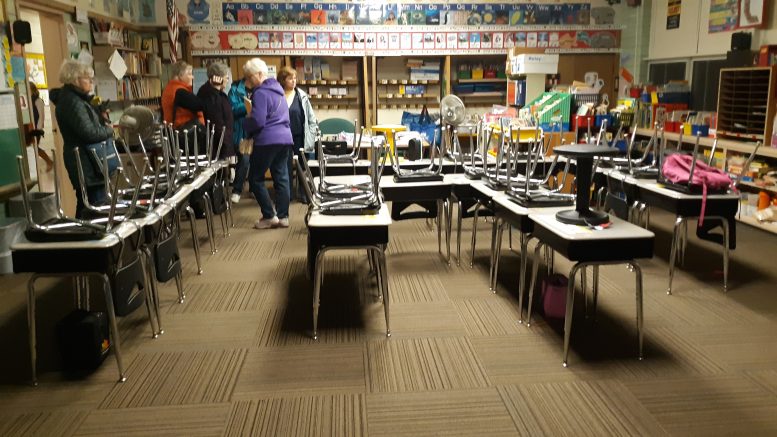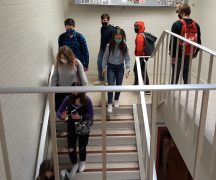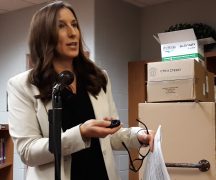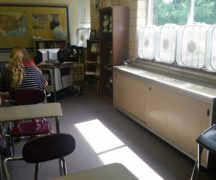By JAN LARSON McLAUGHLIN
BG Independent News
Bowling Green School Board wants to give voters ballot issues they will support. With the sting of the past two bond defeats still fresh, the board members want to select options that voters can solidly endorse as the district prepares to put multiple issues on the ballot in the next couple years.
As they further narrowed down the options during a Saturday work session, the board members appeared to be very close to some decisions.
First, board members voiced commitment to not asking for new money, and preserving the taxpayer rollback for the two levies that need to be renewed by the end of 2020.
However, the question still remains whether the board will try to change those levies into continuing issues, rather than having to go back and ask voters to renew the same money every five years.
Second, the board members voiced firm support of the finance task force’s recommendations that the district place a $40 million combination property and income tax on the ballot this November to fund elementary building projects.
The issue would cost the owner of a $100,000 home $5.12 a month, and a family with the median income of $66,215 annually $13.79 a month – for a total of $18.91 a month.
However, the board is still debating the less precise recommendation from the facilities task force about whether the bond issue should fund three elementaries or one consolidated building.
Third, the board seems solidly behind the finance task force’s recommendation that the district apply for funding from the state through the Expedited Local Partnership Program. The program has no funding now, but could possibly reimburse the district for 17 percent of the building costs when money becomes available.
But the question remains – should the district invest in one or three elementary schools.
The board is torn because when the facilities task force voted on the best elementary option for the district, the members solidly supported one consolidated building. However, when asked to vote based on what the community would support, the vote was overwhelmingly for three elementaries – a new Conneaut, a new Kenwood, plus a renovated and expanded Crim.
One consolidated elementary would be less expensive to maintain, and provide a better and more equitable educational setting – but it may not be the best option for Bowling Green, explained David Conley, the district’s consultant from Rockmill Financial.
“A multiple building solution is the most expensive solution,” Conley said, explaining that three buildings means three roofs to repair, three kitchens and three boilers, etc.
But Bowling Green voters may not support that solution.
“It’s scary to put something on the ballot that’s failed two times,” Conley said.
Board member Norm Geer voiced his concern that while a consolidated elementary may be more cost effective, residents of the district prefer “community schools.”
“We lost 400 votes the second time we ran it,” he said of the last bond issue attempt for a consolidated elementary.
It’s unknown why the bond issues failed. The board and task forces made efforts to address some of the possibilities:
- If it was due to the size of the original $72 million bond issue, the new $40 million issue may be more palatable since it only addresses the elementaries and leaves the high school for later.
- If it was because the entire $72 million would have been raised through property taxes, the new issue splits the cost between income and property taxes.
- If it was due to the length of the bonds, the new issue reduces the time from 37 to 30 years.
That leaves the dilemma of one versus three elementaries as the remaining unknown.
Conley said the board could put both issues on the ballot. But some board members expressed fear that voters would turn down both.
Conley also said the board could have a professional survey conducted to get a better handle on how the voters feel about one versus three elementaries. However, some board members questioned the value of a survey – since few people respond, it will cost at least $10,000, and it will delay any action.
“We have to make a decision,” said board member Bill Clifford. “We have an abundance of information. I think at some point, you just gotta cut bait.”
Board member Jill Carr agreed.
“We took the pause after the second ballot when down, and gave every member of the community an opportunity to participate,” she said of the task force process. “We’re ready to move ahead with a decision on this.”
Board President Ginny Stewart concurred.
“To do a survey is just more money thrown at something that just delays the process,” she said.
“To stall this process does not help us at all,” Stewart said. “It just gets more and more expensive and our schools just get worse and worse.”
Superintendent Francis Scruci pointed out that a survey would get no more than an 18 percent return, and would be “throwing dollars out the window.”
In order to get the issue on the November ballot, the school board will have to make a decision by June 18, Conley said.
“I think we’ve got to come up with something we believe is going to work,” Stewart said.
If the building issue were to pass in November, it would be an estimated three years before construction is completed.
The board was in agreement that task force members should be enlisted to promote the building issue to local voters. Stewart referred to the volunteer task force members as the district’s “best ambassadors.”
Clifford agreed, especially since the ballot language of the combined property/income tax issue will be quite complicated. Ideally, voters will be familiar with the issue before they arrive at the polls, he said.
The board is faced with the fact that even if the building issue passes in November, the district will have to return to the ballot in March of 2020 to renew two levies that will otherwise expire at the end of that year.
Concerned about voter fatigue, the board is considering making both levies continuing – while maintaining the taxpayer discount offered through rollbacks.
“No new taxes is a powerful message,” Geer said.
By making the levies continuing, the district could reduce the amount of money it needs in its budget balance, and it would reduce the number of times the district has to go on the ballot from 15 to seven in the next 20 years.
“You’re constantly coming back to the voters and saying, ‘give us the money you’re already giving us,’” Conley said.
“Why would we not do that,” Carr stressed.
“We told the public, for the first time, we’d come up with a long-term plan,” Stewart said. “I think it shows we’re being much more responsible.”





